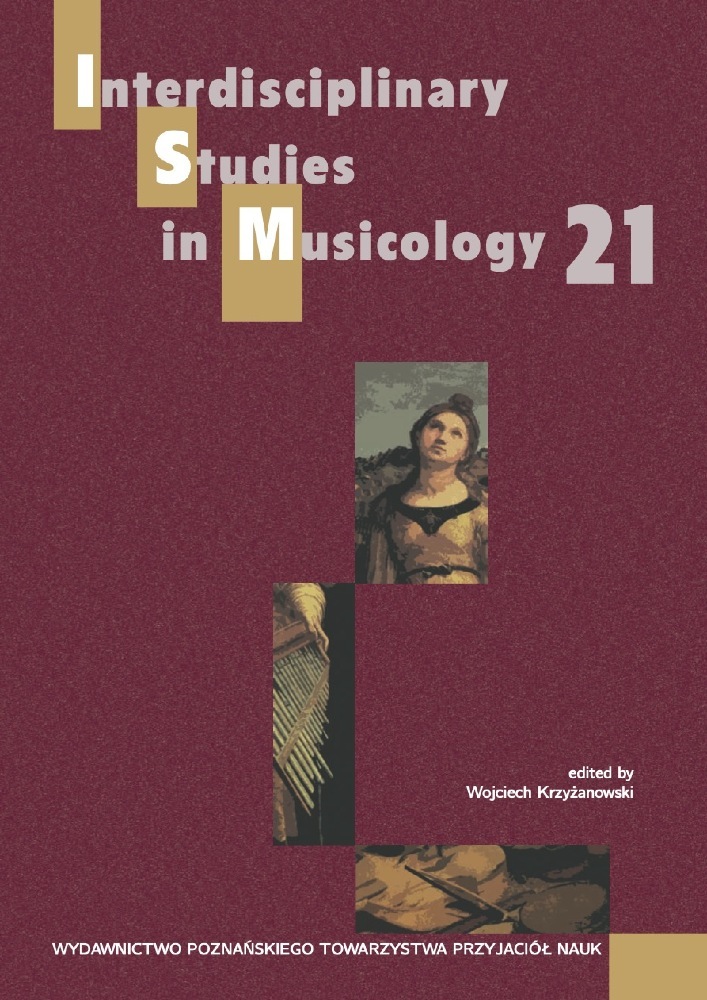Abstract
The present article provides arecontextualization of Wolfgang Caspar Printz’s (1641–1717) landmark music history published in 1690 (Historische Beschreibung der edelen Sing- und Kling-Kunst). later commentators have read it as a primitive, naïve and even failed attempt at writing the history of music. Still, they seem to agree that the text, in virtue of its subject matter, forms part of a canon of music historiography. The present article will seek the interpretative key in the wider intellectual context, outside of the narrow confines of texts about the musical past. It will advance the thesis that Printz built his music historiography from elements of the natural history tradition. Two arguments support this thesis. First, it will be argued that the organization of the material in chapters XIv, Xv and XvI betrays the influence of a classical version of taxonomy closely associated with the natural history tradition. Secondly, that Printz’s inquiry into the purpose of music reveals his reliance on a concept of nature similarly rooted in natural history.
References
Allen, W. D. (1939). Baroque Histories of Music. The Musical Quarterly, 25(2), 195–209.
Aristotle. (1984). The Complete Works of Aristotle, Volume One & Two, (J. Barnes, Ed.). Princeton: Princeton University Press.
Beagon, M. (Ed.). (2005). The Elder Pliny on the Human Animal: Natural History Book 7. Oxford: Clarendon Press.
Benndorf, K. (1894). S. Calvisius als Musiktheoretiker. In F. Chrysander, P. Spitta & G. Adler (Eds.), Vierteljahrsschrift für Musikwissenschaft, Neunter Jahrgang. Leipzig: Druck und Verlag von Breitkopf und Härtel, 411–470.
Burney, C. (1935a). A General History of Music: From the Earliest Ages to the Present Period, Volume the First with Critical and Historical Notes by Frank Mercer. New York: Harcourt, Brace and Company.
Burney, C. (1935b). A General History of Music: From the Earliest Ages to the Present Period, Volume the Second with Critical and Historical Notes by Frank Mercer. New York: Dover Publications, Inc.
Devin, H. (2011). A Sharp Eye for Kinds: Plato on Collection and Division. Oxford Studies in Ancient Philosophy, 41, 229–255.
Falcon, A. (1997). Aristotle’s Theory of Division. Bulletin of the Institute of Classical Studies, 41 (Issue Supplement 68), 127–146.
Foucault, M. (1994). The Order of Things: An Archeology of the Human Sciences. New York: Vintage Books.
Fubini, E. (1994). Music and Culture in Eighteenth-Century Europe: A Source Book, (B. J. Blackburn, Trans. & Ed.). Chicago: The University of Chicago Press.
Hatfield, G. (1990). The Natural and the Normative: Theories of Spatial Perception from Kant to Helmholtz. Cambridge (Mass.): The MIT Press.
Hawkins, J. (1875). A General History of the Science and Practice of Music Vol. 1 & 2. London: Novello, Ewer and Co.
Hegar, E. (1974). Die Anfänge der neueren Musikgeschichtsschreibung um 1770 bei Gerbert, Burney und Hawkins. Baden-Baden: Verlag Valentin Koerner.
Hicks, M. (1984). Soothing the Savage Beast: A Note on Animals and Music. The Journal of Aesthetic Education, 18(4), 47–55.
Jahn, B. (2001). ENCOMIUM MUSICAE und MUSICA HISTORICA, Zur Konzeption von Musikgeschichte im 17. Jahrhundert an Beispielen aus dem schlesisch-sächsischen Raum (Scherffer, Kleinwechter und Printz). Daphnis: Zeitschrift für Mittlere Deutsche Literatur, 30, 491–511.
Kristeller, P. O. (1951). The Modern System of the Arts: A Study in the history of Aesthetics (I). Journal of the History of Ideas, 12(4), 496–527.
Langhans, W. (1887). Die Geschichte der Musik des 17. 18. und 19. Jahrhunderts in chronologischem Anschlusse an die Musikgeschichte von A. W. Ambros, Zweiter Band. Leipzig: Verlag von F. E. C. Leuckart.
Marpurg, F. W. (1759). Kritische Einleitung in die Geschichte und Lehrsätze der alten und neuen Musik. Berlin: Gottlieb August Lange.
Mithobius, H. (1665). Psalmodia Christiana. Jena: In Verlegung Erhardi Bergeri, Buchhändler in Bremen.
Ogilvie, B. W. (2006). The Science of Describing: Natural History in Renaissance Europe. Chicago: The University of Chicago Press.
Osthoff, H. (1933). Die Anfänge der Musikgeschichtsschreibung in Deutschland. Acta Musicologica, 5(3), 97–107.
Plato. (1997). Complete Works (John M. Cooper, Ed.). Indianapolis: Hackett Publishing Company.
Pomata, G & Siraisi, N. G. (Eds.). (2005). Historia: Empiricism and Erudition in Early Modern Europe. Cambridge (Mass.): The MIT Press.
Printz, W. C. (1979). Historische Beschreibung der edelen Sing- und Kling-Kunst. In h. K. Krausse (Ed.) Wolfgang Caspar Printz Ausgewählte Werke, Zweiter Band. Berlin: Walter Gruyter, 241–491.
Schmitz, E. (1904). Studien über W. C. Printz als Musikschriftsteller. In Robert Eitner (Ed.), Monatshefte für Musik-Geschichte Herausgegeben von der Gesellschaft für Musikforschung, 36. Jahrgang. Leipzig: Breitkopf und Härtel, 100–121.
Seifert, A. (1976). Cognitio Historica: Die Geschichte als Namengeberin der frühneuzeitlichen Empirie. Berlin: Duncker &Humblot.
Shiner, l. (2001). The Invention of Art: A Cultural History. Chicago: The University of Chicago Press.
Slaughter, M. (1982). Universal Languages and Scientific Taxonomy in the Seventeenth Century. Cambridge: Cambridge University Press.
Wegman, R. C. (2005). The Crisis of Music in Early Modern Europe, 1470–1530. New York: Routledge.

